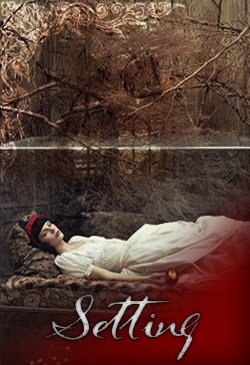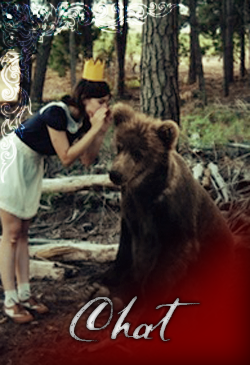Post by pellinore on Oct 22, 2010 16:22:24 GMT -5
Okay, so this plot is still very much in development, because there are several plots holes and characters that I need to fix, but yeah, here it is! ^_^
Title:
Perfect Trust
History:
(Some version of this, minus a few bits, will probably end up in some sort of Prologue or something)
Hundreds of years before this story takes place, there was only one race of people, called the Andarta. They'd been living peacefully for as long as they could remember, but with the discovery of diamonds, some people began to go a bit crazy. Diamonds were so pale, translucent, and solid that the Andarta could only believe that they were supernatural. In fact, when they were discovered, a rumor spread that they had been sent from the moon, for they did bear a resemblence in color and foreignness. Since the moon had always been an object of mystery and wonder, they thought that it and the diamonds must be some sort of divine beings.
Around the settlement, one would have been able to find several shrines where most Andarta went to for worshipping the gods. Eventually, this practice of worshipping morphed into the custom of one person leading a ceremony of worship to the diamonds. Since the community of Andarta was relatively small - less than a thousand - three worship leaders sufficed for the entire settlement. When one died, a new one would immediately be inducted, so there was almost never less than three people, and certainly not more. These three people were always very secretive and covert in all that they did, and in that maintained an air of intimidation and power. They never had any trouble controlling the people at the worshipping ceremonies.
And eventually, they never had trouble controlling anybody. These three leaders that began as merely the leaders of worship became something like the dictators of the settlement of Andarta. They pushed everyone to follow their lifestyle of secrecy and concealment. The hypocritical part of it though, was that although the leaders kept secrets from the rest of the Andarta, and encouraged them to keep secrets from each other, the Andarta were forbidden to conceal anything from the leaders. When an Andart was born, their parents didn't name them - they were brought to the leaders, who then gave the child a name that they would never be allowed to tell anyone, except for the person with the palm-mark that was identical to theirs. After the child was given a name, they were put in a group of other Andarts, called their Gjeng. They would live with these people until they found their match, but they weren't even allowed to tell their Gjeng-mates their name.
Names were believed to have powers that could influence the way someone percieved someone else. If somebody's name was known by another person, the other person would have power over them, power to control and manipulate them without them even realizing why, because knowing their name implies that they know other information about a person, which is naturally intimidating and a bit frightening.
The only person anyone is permitted to tell their name, and anything else, to is the one who has the matching palm-mark. Palm-marks have always been a way for people to identify their perfect match, the person that they were destined to spend the rest of their life with. The Andarta were born with a geometric design on the palm of their hands that matched the one of another Andart born on the same day. They waited their whole lives to find that other person, pair off with them, and finally have someone to share their feelings, thoughts, and most importantly, their name with.
Some Andarts, though, were born with no palm-mark. When the leaders saw a child like this, it was immediately killed. No notification went to the parents, who wouldn't have seen them afterwards anyway. They would eventually find out, and of course they would be upset, but the leaders were frequently unfeeling and harsh with their punishments. Not that children were often born with no palm-marks, it was actually quite a rare occurence. But there were other infringements of the law that required punishment. When the leaders or Lovenholde (the group of Andarta dedicated to keeping the law in place) caught anyone divulging personal information or secrets to someone else, that person would be brought to the leaders to be cut. Cutting was the common form of punishment, and it consisted of the leaders slashing the criminal with a knife - not too deeply, mind, but enough to bleed and scar. These criminals would always have the scars, so people would know that they were rule-breakers.
Another crime sometimes committed was when an Andart was born without being taken to the leaders. One of the only reasons a set of parents would keep their child a secret from the leaders would have been if the child was born without a palm-mark. But not all of these people were punished. In fact, after a while, there were quite a few people without palm-marks. But they were considered inferior, the lowest of the low, not even fit to take part in worship ceremonies. They tended to band together - the people with no palm-marks. Though they were not allowed to have children, or tell anyone their names, it was rumored that these unmarked people were slowly creating their own secret community, hidden from the bulk of the Andarta. In their small community, they began to reproduce with each other, creating more unmarked children. These people accumulated so that eventually, their numbers were large enough to rival those of the Andarta.
This was the beginning of The Separation. The unmarked people were tired of this secrecy, these unnecessary rules. After gathering up all their people, these unmarked Andarta slowly began leaving the settlement. It went unnoticed at first, since they were already so secluded from every day life, and by the time the leaders and everyone else noticed, it was too late. The unmarked ones had too big a group to be overtaken by the leaders, so they decided to just let them be.
Over time, these unmarked ones became a completely separate race from the Andarta. They made their own laws, ones that didn't include any sort of secrecy, or overly privateness. Parents named their own children, and were allowed to marry whomever they wanted. They eventually began calling themselves 'Humans'.
Because the Andarta chose to continue living in such secrecy, and the Humans in such openness and freedom, eventually the humans were unable to even see the Andarta. The Andarta could see, hear, and feel the humans, and could interact with them if they so chose, but the humans could not do the same to them. The only interaction between the humans and Andarta was indirect, when the Andarta slipped into the human village to search for any diamonds they might have found. They knew the humans dug for diamonds, and every so often they found one or two on their raids. Many of the Andarta were still very much fanatical about these diamonds that they kept occasionally digging up from the ground, and thought that the humans, as such an inferior race, did not deserve to possess them.
General Setting:
Sometime around the 1500 or 1600s, in a peasant village in England. Where it is isn't particularly important, just that they don't have anything like electricity or cars or flashlights.
Andarta live in the forest behind the human village, in large huts spanning over several trees, built on top of the branches.
Andarta:
--general:
They are mostly nocturnal, so they sleep in their huts during the day and come out to do whatever they do around the time when the sun goes down.
--appearance:
A bit smaller than humans, with paler skin that has a bit of a bluish tint, because they never really get into the sun. They are usually muscular and very nimble, because they do a lot of leaping from hut to hut, since they are built in trees. Also, they keep their hair long, because it tends to get cold. The females wear it either loose or in braids, normally, though their is no right or wrong way for them to do their hair. The males usually keep their hair back in a ponytail.
--clothing:
Most of the Andarta's clothing is made of animals skins. Sometimes the females wear jewellery made out of twigs or stones, or even teeth of the animals. Usually, they all wear some variation on tunics and leggings, though the females sometimes wear dresses.
--diet:
Since they live in the forest, the Andarta's diet includes a lot of berries and fruits, and some plant leaves. Also, they eat some of the larger animals that they find, like deer, rabbit, and some birds. When they raid the human village, sometimes they'll steal a cow or two, but it usually goes to the leaders because it is so rare for them.
--palm-mark:
Palm-marks are small, black little designs in the palm of their hands. The have the same exact mark on both hands, and a matching set on another person. Usually, the palm marks are in the general shape of a square and in the center of the palm.

(yes, i did draw on my hand with pen then take a picture of it )
)
Characters:
LE
(Main Character)
(about 16 or 17 years old)
She has started becoming kind of bitter and depressed, because the boy whose palm-mark matches hers (Jud) is very unrefined and rude. Her parents keep trying to talk to her about him, but she never goes into depth. She wouldn't want to worry them with her feelings of hatred towards him, and also talking of things like that is not considered good etiquette. When she falls in love with William, she often says awkward things that make him think she's weird, but she is smart and can think quickly in pressing situations.
WILLIAM BACKER
(human boy that Le falls in love with)
(the same age as Le, however old she is)
He is very kind, and very protective of his younger sister. His parents don't want him getting married because they are ill and they need him to help take care of his sister. He thinks Le is a freak at first, but then realizes after they've gone on some undecided adventure together, that he actually does love her.
GENEVIEVE BACKER
(William's little sister)
(about 10)
She is kind of similar to Le, in that she is a bit depressed. She sees her parents all sick and everything and it makes her sad. Also, she has some deformity on her face (I'm not quite sure what yet) that makes her kind of an outcast with the kids her age. She loves her brother, but is sometimes mean to him just because she is angry in general, but he always forgives her. She and Le get along well.
JUD
(Andart who has a palm-mark that matches Le's)
(About the same age as Le and William)
Jud is not very well-liked, because he is a bit obnoxious and annoying. He acts stuck up, and raises these salamanders in his room that he tries to show off to everyone, but nobody really cares. He thinks Le is pretty and that she's nice, but that she should wear dresses instead of tunics and leggings because he thinks what she usually wears makes her look manly (and he often tells her this.) He doesn't have a very good sense of other people's feelings, and is always just crossing the line enough to aggravate everybody. It is hard for him to tell when he isn't wanted in a conversation, so he often ends up in places where he shouldn't be.
ETA
(Le's friend)
(16 years old)
Sleeps a lot. Some people suspect that she is sneaking out while everyone else is asleep, and she does. She goes and tries to set Jud's salamanders free, because she thinks that it is wrong to keep animals in cages, and even to eat them. Eta only wears clothes made out of tree bark and leaves and such, and doesn't eat animals. She hints to Le that she wants to know what's going on, and where she goes when she leaves the settlement, but would never ask directly. She's a bit shy, and not the smartest, but very kind and innocent.
NRUK
(Andarta, one of the Lovenholde)
(about 30)
Starts following Le when he suspects that she is sneaking off to go to the human village. Hesitates to tell the leaders about it because he is a good person, and doesn't want her to get hurt. He tries to talk to her and tell her that what she is doing is dangerous.
ITTAIPALU
(a dragon!)
(Really old)
Attacks Le and William sometime on their adventure through the country but somehow ends up swallowing a shovel (traveling shovel of death, woo! -- this may or may not actually happen), which kills him.
--more characters to come!
Plot:
When Le finally finds the one with the palm-mark that matches hers – the one she is destined to be with for the rest of her life – she must face up to the challenge bestowed upon her by god or whoever controlled everything. The boy with the identical palm-mark, her perfect match, is a human, while Le remains is a member of a race called the Andarta.
The leaders of the Andarta have always told their subjects that the humans are an inferior race – they go through their life with no regard for secrecy or privacy. They all know each other’s names, and let one another in on their personal feelings and thoughts. The Andarta do none of this; they have a belief that if anyone knows too much about a person, they have power over them. This is why the leaders name everyone born into the Andarta, and why the only ones the Andarta are permitted to tell their name to is the one whose palm-mark matches theirs. The matching palm-marks are what show the Andarta that they can completely trust that person, that they were meant to trust them from birth.
But because of this way of life, and because she knew she would be punished for having a palm-mark that matches a human’s, Le could not tell anyone about this. When she finally found a way to tell William, the boy with the matching palm-mark, not even he believes her, because he isn't able to see what is on his own hand. With the help of a few other characters, and some unexpected enemies, Le and William find themselves farther from their own villages than they would ever expect to be. At first they want to find their way back, but eventually they realize that they would rather continue their lives in this new place with each other than go back to a life where they would have to continue being separated.
-WIP-
Title:
Perfect Trust
History:
(Some version of this, minus a few bits, will probably end up in some sort of Prologue or something)
Hundreds of years before this story takes place, there was only one race of people, called the Andarta. They'd been living peacefully for as long as they could remember, but with the discovery of diamonds, some people began to go a bit crazy. Diamonds were so pale, translucent, and solid that the Andarta could only believe that they were supernatural. In fact, when they were discovered, a rumor spread that they had been sent from the moon, for they did bear a resemblence in color and foreignness. Since the moon had always been an object of mystery and wonder, they thought that it and the diamonds must be some sort of divine beings.
Around the settlement, one would have been able to find several shrines where most Andarta went to for worshipping the gods. Eventually, this practice of worshipping morphed into the custom of one person leading a ceremony of worship to the diamonds. Since the community of Andarta was relatively small - less than a thousand - three worship leaders sufficed for the entire settlement. When one died, a new one would immediately be inducted, so there was almost never less than three people, and certainly not more. These three people were always very secretive and covert in all that they did, and in that maintained an air of intimidation and power. They never had any trouble controlling the people at the worshipping ceremonies.
And eventually, they never had trouble controlling anybody. These three leaders that began as merely the leaders of worship became something like the dictators of the settlement of Andarta. They pushed everyone to follow their lifestyle of secrecy and concealment. The hypocritical part of it though, was that although the leaders kept secrets from the rest of the Andarta, and encouraged them to keep secrets from each other, the Andarta were forbidden to conceal anything from the leaders. When an Andart was born, their parents didn't name them - they were brought to the leaders, who then gave the child a name that they would never be allowed to tell anyone, except for the person with the palm-mark that was identical to theirs. After the child was given a name, they were put in a group of other Andarts, called their Gjeng. They would live with these people until they found their match, but they weren't even allowed to tell their Gjeng-mates their name.
Names were believed to have powers that could influence the way someone percieved someone else. If somebody's name was known by another person, the other person would have power over them, power to control and manipulate them without them even realizing why, because knowing their name implies that they know other information about a person, which is naturally intimidating and a bit frightening.
The only person anyone is permitted to tell their name, and anything else, to is the one who has the matching palm-mark. Palm-marks have always been a way for people to identify their perfect match, the person that they were destined to spend the rest of their life with. The Andarta were born with a geometric design on the palm of their hands that matched the one of another Andart born on the same day. They waited their whole lives to find that other person, pair off with them, and finally have someone to share their feelings, thoughts, and most importantly, their name with.
Some Andarts, though, were born with no palm-mark. When the leaders saw a child like this, it was immediately killed. No notification went to the parents, who wouldn't have seen them afterwards anyway. They would eventually find out, and of course they would be upset, but the leaders were frequently unfeeling and harsh with their punishments. Not that children were often born with no palm-marks, it was actually quite a rare occurence. But there were other infringements of the law that required punishment. When the leaders or Lovenholde (the group of Andarta dedicated to keeping the law in place) caught anyone divulging personal information or secrets to someone else, that person would be brought to the leaders to be cut. Cutting was the common form of punishment, and it consisted of the leaders slashing the criminal with a knife - not too deeply, mind, but enough to bleed and scar. These criminals would always have the scars, so people would know that they were rule-breakers.
Another crime sometimes committed was when an Andart was born without being taken to the leaders. One of the only reasons a set of parents would keep their child a secret from the leaders would have been if the child was born without a palm-mark. But not all of these people were punished. In fact, after a while, there were quite a few people without palm-marks. But they were considered inferior, the lowest of the low, not even fit to take part in worship ceremonies. They tended to band together - the people with no palm-marks. Though they were not allowed to have children, or tell anyone their names, it was rumored that these unmarked people were slowly creating their own secret community, hidden from the bulk of the Andarta. In their small community, they began to reproduce with each other, creating more unmarked children. These people accumulated so that eventually, their numbers were large enough to rival those of the Andarta.
This was the beginning of The Separation. The unmarked people were tired of this secrecy, these unnecessary rules. After gathering up all their people, these unmarked Andarta slowly began leaving the settlement. It went unnoticed at first, since they were already so secluded from every day life, and by the time the leaders and everyone else noticed, it was too late. The unmarked ones had too big a group to be overtaken by the leaders, so they decided to just let them be.
Over time, these unmarked ones became a completely separate race from the Andarta. They made their own laws, ones that didn't include any sort of secrecy, or overly privateness. Parents named their own children, and were allowed to marry whomever they wanted. They eventually began calling themselves 'Humans'.
Because the Andarta chose to continue living in such secrecy, and the Humans in such openness and freedom, eventually the humans were unable to even see the Andarta. The Andarta could see, hear, and feel the humans, and could interact with them if they so chose, but the humans could not do the same to them. The only interaction between the humans and Andarta was indirect, when the Andarta slipped into the human village to search for any diamonds they might have found. They knew the humans dug for diamonds, and every so often they found one or two on their raids. Many of the Andarta were still very much fanatical about these diamonds that they kept occasionally digging up from the ground, and thought that the humans, as such an inferior race, did not deserve to possess them.
General Setting:
Sometime around the 1500 or 1600s, in a peasant village in England. Where it is isn't particularly important, just that they don't have anything like electricity or cars or flashlights.
Andarta live in the forest behind the human village, in large huts spanning over several trees, built on top of the branches.
Andarta:
--general:
They are mostly nocturnal, so they sleep in their huts during the day and come out to do whatever they do around the time when the sun goes down.
--appearance:
A bit smaller than humans, with paler skin that has a bit of a bluish tint, because they never really get into the sun. They are usually muscular and very nimble, because they do a lot of leaping from hut to hut, since they are built in trees. Also, they keep their hair long, because it tends to get cold. The females wear it either loose or in braids, normally, though their is no right or wrong way for them to do their hair. The males usually keep their hair back in a ponytail.
--clothing:
Most of the Andarta's clothing is made of animals skins. Sometimes the females wear jewellery made out of twigs or stones, or even teeth of the animals. Usually, they all wear some variation on tunics and leggings, though the females sometimes wear dresses.
--diet:
Since they live in the forest, the Andarta's diet includes a lot of berries and fruits, and some plant leaves. Also, they eat some of the larger animals that they find, like deer, rabbit, and some birds. When they raid the human village, sometimes they'll steal a cow or two, but it usually goes to the leaders because it is so rare for them.
--palm-mark:
Palm-marks are small, black little designs in the palm of their hands. The have the same exact mark on both hands, and a matching set on another person. Usually, the palm marks are in the general shape of a square and in the center of the palm.

(yes, i did draw on my hand with pen then take a picture of it
 )
)Characters:
LE
(Main Character)
(about 16 or 17 years old)
She has started becoming kind of bitter and depressed, because the boy whose palm-mark matches hers (Jud) is very unrefined and rude. Her parents keep trying to talk to her about him, but she never goes into depth. She wouldn't want to worry them with her feelings of hatred towards him, and also talking of things like that is not considered good etiquette. When she falls in love with William, she often says awkward things that make him think she's weird, but she is smart and can think quickly in pressing situations.
WILLIAM BACKER
(human boy that Le falls in love with)
(the same age as Le, however old she is)
He is very kind, and very protective of his younger sister. His parents don't want him getting married because they are ill and they need him to help take care of his sister. He thinks Le is a freak at first, but then realizes after they've gone on some undecided adventure together, that he actually does love her.
GENEVIEVE BACKER
(William's little sister)
(about 10)
She is kind of similar to Le, in that she is a bit depressed. She sees her parents all sick and everything and it makes her sad. Also, she has some deformity on her face (I'm not quite sure what yet) that makes her kind of an outcast with the kids her age. She loves her brother, but is sometimes mean to him just because she is angry in general, but he always forgives her. She and Le get along well.
JUD
(Andart who has a palm-mark that matches Le's)
(About the same age as Le and William)
Jud is not very well-liked, because he is a bit obnoxious and annoying. He acts stuck up, and raises these salamanders in his room that he tries to show off to everyone, but nobody really cares. He thinks Le is pretty and that she's nice, but that she should wear dresses instead of tunics and leggings because he thinks what she usually wears makes her look manly (and he often tells her this.) He doesn't have a very good sense of other people's feelings, and is always just crossing the line enough to aggravate everybody. It is hard for him to tell when he isn't wanted in a conversation, so he often ends up in places where he shouldn't be.
ETA
(Le's friend)
(16 years old)
Sleeps a lot. Some people suspect that she is sneaking out while everyone else is asleep, and she does. She goes and tries to set Jud's salamanders free, because she thinks that it is wrong to keep animals in cages, and even to eat them. Eta only wears clothes made out of tree bark and leaves and such, and doesn't eat animals. She hints to Le that she wants to know what's going on, and where she goes when she leaves the settlement, but would never ask directly. She's a bit shy, and not the smartest, but very kind and innocent.
NRUK
(Andarta, one of the Lovenholde)
(about 30)
Starts following Le when he suspects that she is sneaking off to go to the human village. Hesitates to tell the leaders about it because he is a good person, and doesn't want her to get hurt. He tries to talk to her and tell her that what she is doing is dangerous.
ITTAIPALU
(a dragon!)
(Really old)
Attacks Le and William sometime on their adventure through the country but somehow ends up swallowing a shovel (traveling shovel of death, woo! -- this may or may not actually happen), which kills him.
--more characters to come!
Plot:
When Le finally finds the one with the palm-mark that matches hers – the one she is destined to be with for the rest of her life – she must face up to the challenge bestowed upon her by god or whoever controlled everything. The boy with the identical palm-mark, her perfect match, is a human, while Le remains is a member of a race called the Andarta.
The leaders of the Andarta have always told their subjects that the humans are an inferior race – they go through their life with no regard for secrecy or privacy. They all know each other’s names, and let one another in on their personal feelings and thoughts. The Andarta do none of this; they have a belief that if anyone knows too much about a person, they have power over them. This is why the leaders name everyone born into the Andarta, and why the only ones the Andarta are permitted to tell their name to is the one whose palm-mark matches theirs. The matching palm-marks are what show the Andarta that they can completely trust that person, that they were meant to trust them from birth.
But because of this way of life, and because she knew she would be punished for having a palm-mark that matches a human’s, Le could not tell anyone about this. When she finally found a way to tell William, the boy with the matching palm-mark, not even he believes her, because he isn't able to see what is on his own hand. With the help of a few other characters, and some unexpected enemies, Le and William find themselves farther from their own villages than they would ever expect to be. At first they want to find their way back, but eventually they realize that they would rather continue their lives in this new place with each other than go back to a life where they would have to continue being separated.
-WIP-









